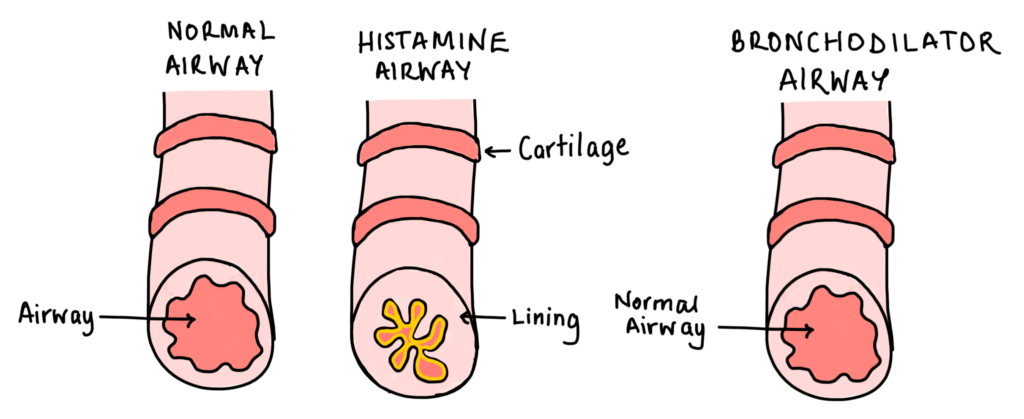Have you ever found yourself in the presence of a friend who is having an asthma attack, or have you ever experienced one yourself? This can be a very scary experience, and many people don’t know what Asthma is or how to help in this situation. Keep reading for a more in-depth understanding of Asthma and how we manage it as a disease.
Asthma is a long-term lung condition that affects the airways responsible for carrying air and oxygen to and from the lungs. In individuals with asthma, these airways become swollen and tighten, leading to a significant narrowing of the airway. This restriction results in reduced oxygen delivery to the lungs. The primary airways impacted by asthma is the trachea, commonly known as the windpipe. Smaller airways are also greatly affected in Asthma. During an asthma attack, the lining of the trachea swells and narrows considerably, making it more difficult for oxygen to reach the lungs.

Image created by Dr Mojibola Orefuja
In the lungs, small air sacs called alveoli play a crucial role in a process called Gas Exchange. These sacs collect oxygen and aid its transfer into the bloodstream while simultaneously releasing carbon dioxide back into the environment. When the airways become narrow in asthma, carbon dioxide becomes trapped within the lungs, preventing adequate oxygen intake. This imbalance can cause further complications, as the body’s tissues receive oxygen that is not enough to function optimally.
Risk Factors and Triggers
The exact cause of asthma remains unknown. While lots of theories suggest potential links to conditions like hay fever and eczema, as well as other allergies, no definitive research has identified a clear, direct cause for asthma or why it affects certain individuals.
Research has, however, established that certain genetic and environmental factors influence an individual’s likelihood of developing asthma. The most significant risk factor is family history. If a close family member, such as a parent or sibling, has or has had asthma, the likelihood of developing the condition increases significantly.
Additional factors that may increase the risk of having/developing asthma include:
- Exposure to tobacco smoke
- Prematurity or low birth weight
- Obesity
- Social isolation or withdrawal
- Exposure to airborne particles
- Childhood lung conditions
An asthma attack can be triggered by various factors, including:
- Weather changes
- Physical exercise
- Smoking
- Aerosols
- Pollen and other allergens
Recognizing and understanding these triggers is essential for effective asthma management. When you notice a pattern of worsening breathing symptoms related to specific triggers, it is important to consult a healthcare professional. Early diagnosis plays a critical role in managing asthma and preventing complications.
Signs and Symptoms
The hallmark symptom of asthma is breathlessness. This is described as shortness of breath, rapid breathing, or difficulty getting air into the lungs. Difficult breathing is often triggered in individuals with asthma. Common triggers include cold air, exercise, infection, certain medications (such as pain or heart medications), and other specific factors. Additional symptoms that commonly accompany breathlessness include:
- Wheeze
- Cough
- Chest tightness
- Noisy breathing
In some individuals, asthma symptoms present predominantly in the morning and at night, with no significant occurrences during the day.
Diagnosis
Asthma is diagnosed by combining reported symptoms with the results of tests that assess lung function. There are three main diagnostic tests for asthma:
- Blood Eosinophilia Testing – This blood test measures the level of eosinophils in the blood. Eosinophils, a type of immune cell, increase during allergic or atopic reactions. In asthma, an atopic condition, elevated eosinophil levels often indicate an allergic response, aiding in diagnosis.
- Alternatively, a Fractional Exhaled Nitric Oxide (FeNO) test measures the amount of nitric oxide in a person’s breath, indicating irritated airways, which is a hallmark of asthma.
- Spirometry – This specialized lung function test measures various lung volumes and capacities, such as the total volume of air the lungs can hold during a deep breath and the volume exhaled during a normal breath. Asthma alters these values due to reduced breathing ability.
- To confirm asthma, a substance called histamine is sometimes introduced to mimic asthma symptoms. The individual performs spirometry by breathing normally into a mouthpiece to measure baseline values. After receiving histamine, breathing typically worsens, but administration of asthma treatment should restore normal breathing. This technique is called Bronchodilator Reversibility Testing.
- Peak Flow – This test uses a small device to measure how quickly a person can blow air out of their lungs. On a normal day, a person can blow out air quickly. During an asthma attack, the airways become narrower, making it harder to blow out air. This trapped air makes breathing more difficult.

Image created by Dr Mojibola Orefuja
Treatment
Asthma treatment includes both medicines and lifestyle changes to help control symptoms.
Non-Medicine Approaches
- Stay up to date with vaccinations – Vaccinations are very important for people with lung conditions. Infections can make asthma much worse and may even lead to hospitalization. Vaccinations can lower the risk of serious asthma attacks by helping prevent infections.
- Avoid triggers – Avoiding things that cause asthma symptoms is important to prevent attacks. Identifying these triggers and finding ways to stay away from them can help manage asthma without major lifestyle changes.
- Improve lifestyle habits – Smoking and being overweight can make asthma worse. Quitting smoking and losing weight can greatly improve asthma symptoms and reduce the chances of serious attacks.
Medicine-Based Treatment
Asthma medicines are usually given through inhalers, but in severe cases, tablets or medicines given directly into a vein (IV) may be needed. Doctors use a step-by-step approach to manage asthma based on how bad the symptoms are:
- Starting Treatment – When asthma is first diagnosed, doctors usually prescribe an inhaler for symptom relief. This inhaler contains low-dose steroids and a long-acting bronchodilator. This is an inhaler that you use when breathing becomes much worse very quickly or when someone is having an asthma attack. If this doesn’t help. call the ambulance straight away.
- Bronchodilators help open up the airways by either blocking signals that cause narrowing or encouraging the airways to relax and open wider.
- Adding Preventive Treatment – If a person needs to use their initial inhaler often, a second inhaler is prescribed. This new inhaler is used every day to stop symptoms from happening. It contains similar medicines but is taken every day to prevent problems.
- At this point, the person uses one inhaler daily to prevent symptoms and another inhaler when symptoms occur.
- The doctor may increase the dose of the daily inhaler if symptoms are not well controlled.
- Advanced Treatment Options – For more severe cases, doctors may refer the person to a specialist or recommend additional tests.If someone has a mild or moderate asthma attack, their doctor may prescribe a short course of steroid tablets to reduce swelling in the lungs. This treatment usually lasts 3-5 days and is not the same as the steroids used for building muscle.
By combining lifestyle changes with the right medicines, people with asthma can manage their symptoms and improve their quality of life.
References:
- Asthma + Lung UK. What is Asthma? [Internet]. Available from: https://www.asthmaandlung.org.uk/conditions/asthma/what-asthma
- National Institute for Health and Care Excellence (NICE). Asthma [Internet]. Clinical Knowledge Summaries (CKS). Available from: https://cks.nice.org.uk/topics/asthma/
- National Institute for Health and Care Excellence (NICE). Objective tests for diagnosing asthma in adults, young people, and children aged 5 to 16 [Internet]. Recommendations: NICE Guideline NG245. Available from: https://www.nice.org.uk/guidance/ng245/chapter/Recommendations#objective-tests-for-diagnosing-asthma-in-adults-young-people-and-children-aged-5-to-16-with-a
- National Institute for Health and Care Excellence (NICE). Products \u2013 Asthma | Topic | NICE [Internet]. Respiratory Conditions Guidance. Available from: https://www.nice.org.uk/guidance/conditions-and-diseases/respiratory-conditions/asthma/products?ProductType=Guidance&Status=Published
- British National Formulary (BNF). Asthma, Acute [Internet]. NICE. Available from: https://bnf.nice.org.uk/treatment-summaries/asthma-acute/
